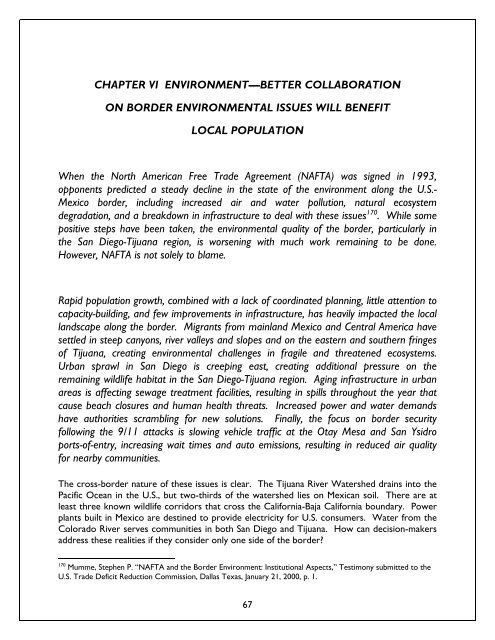Blurred Borders - International Community Foundation
Blurred Borders - International Community Foundation
Blurred Borders - International Community Foundation
Create successful ePaper yourself
Turn your PDF publications into a flip-book with our unique Google optimized e-Paper software.
CHAPTER VI ENVIRONMENT—BETTER COLLABORATION<br />
ON BORDER ENVIRONMENTAL ISSUES WILL BENEFIT<br />
LOCAL POPULATION<br />
When the North American Free Trade Agreement (NAFTA) was signed in 1993,<br />
opponents predicted a steady decline in the state of the environment along the U.S.-<br />
Mexico border, including increased air and water pollution, natural ecosystem<br />
degradation, and a breakdown in infrastructure to deal with these issues 170 . While some<br />
positive steps have been taken, the environmental quality of the border, particularly in<br />
the San Diego-Tijuana region, is worsening with much work remaining to be done.<br />
However, NAFTA is not solely to blame.<br />
Rapid population growth, combined with a lack of coordinated planning, little attention to<br />
capacity-building, and few improvements in infrastructure, has heavily impacted the local<br />
landscape along the border. Migrants from mainland Mexico and Central America have<br />
settled in steep canyons, river valleys and slopes and on the eastern and southern fringes<br />
of Tijuana, creating environmental challenges in fragile and threatened ecosystems.<br />
Urban sprawl in San Diego is creeping east, creating additional pressure on the<br />
remaining wildlife habitat in the San Diego-Tijuana region. Aging infrastructure in urban<br />
areas is affecting sewage treatment facilities, resulting in spills throughout the year that<br />
cause beach closures and human health threats. Increased power and water demands<br />
have authorities scrambling for new solutions. Finally, the focus on border security<br />
following the 9/11 attacks is slowing vehicle traffic at the Otay Mesa and San Ysidro<br />
ports-of-entry, increasing wait times and auto emissions, resulting in reduced air quality<br />
for nearby communities.<br />
The cross-border nature of these issues is clear. The Tijuana River Watershed drains into the<br />
Pacific Ocean in the U.S., but two-thirds of the watershed lies on Mexican soil. There are at<br />
least three known wildlife corridors that cross the California-Baja California boundary. Power<br />
plants built in Mexico are destined to provide electricity for U.S. consumers. Water from the<br />
Colorado River serves communities in both San Diego and Tijuana. How can decision-makers<br />
address these realities if they consider only one side of the border?<br />
170 Mumme, Stephen P. “NAFTA and the Border Environment: Institutional Aspects,” Testimony submitted to the<br />
U.S. Trade Deficit Reduction Commission, Dallas Texas, January 21, 2000, p. 1.<br />
67















